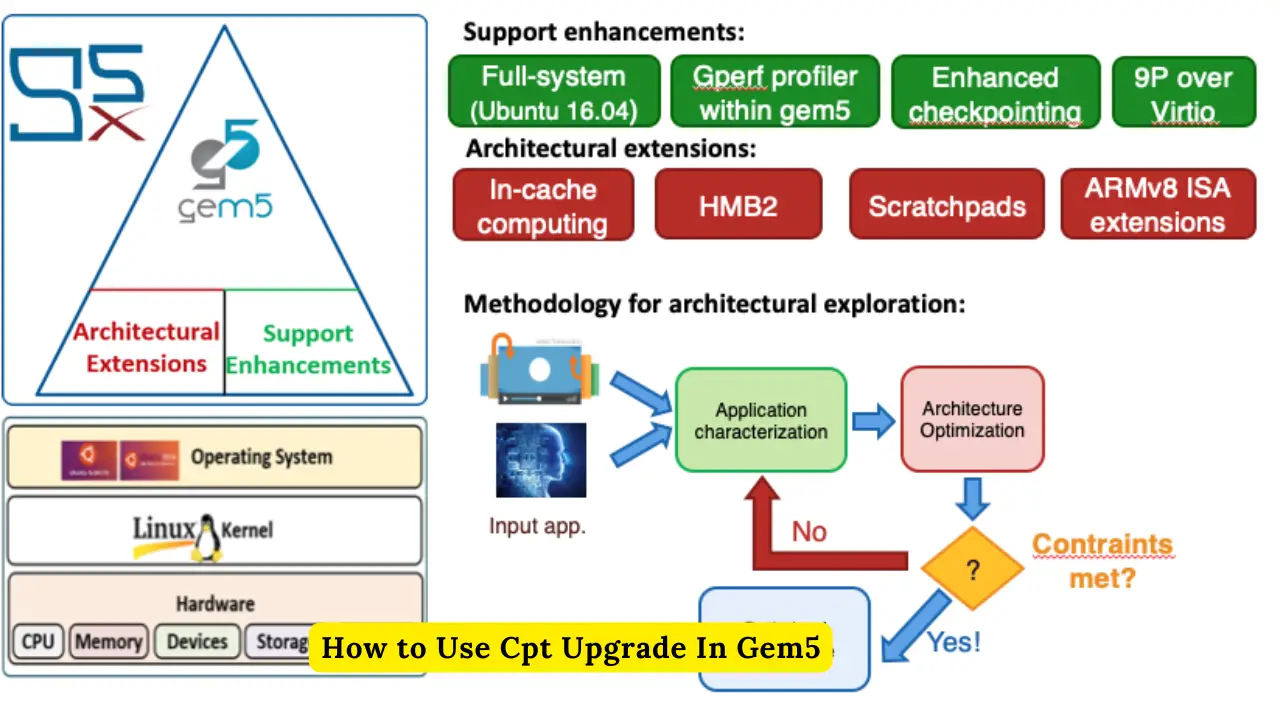
How to Use Cpt Upgrade In Gem5
Gem5 is a powerful and widely utilized simulator within the research community, especially for studying and analyzing computer architecture. Among its numerous utilities, cpt_upgrader.py stands out as an essential tool for maintaining the compatibility of checkpoint files across different versions of the simulator. This detailed guide explores the purpose, functionality, and practical usage of cpt_upgrader.py, ensuring that your checkpoint files remain operational and efficient, regardless of the version of Gem5 you are working with. How to Use Cpt Upgrade In Gem5
What is cpt_upgrader.py and Why It’s Important?
cpt_upgrader.py is a Python script located in the directory of the gem5-mirror repository. Its primary function is to upgrade checkpoint files that were created in older versions of Gem5 so that they can be used with newer versions.
Checkpoints are crucial in Gem5 simulations as they represent a saved state of the simulation, allowing users to pause and resume their work without restarting from the beginning. As Gem5 evolves, the internal data structures often change, rendering older checkpoints incompatible with newer versions. cpt_upgrader.py ensures these checkpoints can be updated to align with the latest version, saving time and computational resources by avoiding the need to restart simulations.
How cpt_upgrader.py Functions
Parsing the Checkpoint File
The first task that cpt_upgrader.py performs is parsing the existing checkpoint file. This involves reading the file to identify the version of Gem5 it was created with. Identifying the correct version is critical, as it helps determine what specific changes are needed to bring the checkpoint file up to date.
Identifying Necessary Upgrades
Once the version is identified, cpt_upgrader.py compares the data structures within the checkpoint file against those used in the current version of Gem5. This comparison helps the script generate a list of required upgrades, which could include adjustments to data formats, object structures, or other essential elements.
Applying the Upgrades
With the list of necessary changes in hand, cpt_upgrader.py systematically applies these upgrades to the checkpoint file. The script takes great care to preserve the integrity of the original simulation data while ensuring compatibility with the current version of Gem5. This process is handled meticulously to maintain consistency with the newer version’s data structures and formats.
Verifying the Upgraded Checkpoint
After applying the upgrades, cpt_upgrader.py performs a verification step. This crucial step ensures that the upgraded checkpoint file is fully functional and compatible with the current version of Gem5. Proper verification helps prevent errors during simulation runs and confirms that the checkpoint upgrade was successful.
Using cpt_upgrader.py: A Step-by-Step Guide
1. Locate the cpt_upgrader.py Script
The cpt_upgrader.py script is located in the directory of the gem5-mirror repository. Before you start, ensure that you have the latest version of this repository cloned into your local environment.
2. Prepare Your Checkpoint File
Identify the checkpoint file that you want to upgrade. It is always a good practice to create a backup of the original file before running the upgrade process, as this ensures you can revert to the original if needed.
3. Execute the Script
To upgrade your checkpoint, run the cpt_upgrader.py script from the command line. You will need to pass the path to your checkpoint file as an argument. The command structure is as follows:
4. Review the Output
After running the script, it will provide an output that details the changes made to the checkpoint file. Carefully review this output to ensure that all necessary upgrades were applied successfully.
5. Test the Upgraded Checkpoint
Finally, load the upgraded checkpoint file in your current version of Gem5 to verify its functionality. Testing the file is crucial to confirm that the upgrade process was successful and that the checkpoint file operates as expected in the newer version.
Advanced Tips for Optimizing cpt_upgrader.py Usage
Always Maintain a Backup
Always keep a backup of your original checkpoint files before performing any upgrades. This precaution allows you to revert to the previous version if something goes wrong during the upgrade process.
Stay Updated with the Latest Version
The Gem5 simulator is under continuous development, with regular updates that may include bug fixes or enhancements to utilities like cpt_upgrader.py. Ensure that you are always using the latest version of the script to take advantage of these improvements.
Consult the Official Documentation
The Gem5 community offers extensive documentation and support. If you encounter any issues or uncertainties while using cpt_upgrader.py, refer to the official documentation or seek help from community forums for guidance.
Consider Automating the Upgrade Process
For users frequently dealing with multiple checkpoints, automating the upgrade process might be beneficial. You can create a wrapper script that iterates over multiple checkpoint files, applying cpt_upgrader.py automatically. This approach can save time and reduce the chance of manual errors.
Common Pitfalls and How to Avoid Them
Version Mismatch
One common issue users face is attempting to upgrade a checkpoint file with an incorrect version of cpt_upgrader.py. Always ensure that the script version matches the Gem5 version of your current simulation environment.
Incomplete Upgrades
Sometimes, the upgrade process may not apply all necessary changes, leading to errors when loading the checkpoint. To avoid this, meticulously review the script’s output after each upgrade and perform thorough testing of the upgraded checkpoint.
Ignoring Compatibility Checks
Neglecting to verify the compatibility of upgraded checkpoint files can lead to significant issues during simulation runs. Always test the upgraded file in a safe environment before deploying it in critical simulations.
Conclusion
The cpt_upgrader.py script is an indispensable tool for anyone working with checkpoints in Gem5. By following the comprehensive guide outlined above, you can ensure that your checkpoint files remain compatible and functional across various versions of Gem5. This not only enhances the efficiency of your research and development work but also saves valuable time and resources.






